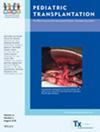小儿肺移植中的柔性支气管镜检查
IF 1.2
4区 医学
Q3 PEDIATRICS
引用次数: 0
摘要
对于患有晚期肺病或肺血管疾病并被认为是合适人选的儿童来说,小儿肺移植是一种治疗选择。小儿柔性支气管镜是一个重要且不断发展的领域,与小儿肺移植人群高度相关。因此,提高我们的知识水平以更好地了解如何利用小儿支气管镜最大限度地优化肺移植术后儿童的护理非常重要。我们的目标是不断提高支气管镜检查的操作技能,降低并发症发生率,同时获取足够的样本进行诊断评估。实现这些目标至关重要,因为通过支气管镜活检对异体移植物进行评估是组织学诊断急性细胞排斥反应的必要条件,也是确定肺移植后常见并发症--慢性肺异体移植物功能障碍的重要因素。柔性支气管镜与支气管肺泡灌洗和经支气管肺活检在肺移植移植物评估中发挥着关键作用。在本文中,我们将讨论支气管镜在小儿肺移植评估中的应用,包括历史方法、我们的经验以及支气管镜和不断发展的小儿肺移植领域的未来方向。小儿柔性支气管镜已成为诊断儿童肺移植并发症和评估治疗反应的重要方式。在此,我们回顾了柔性支气管镜在儿童肺移植术后管理中的价值,讨论了如何应用新技术改善对这一复杂的儿科患者群体的护理,并简要介绍了在不断发展的肺移植领域应用的新诊断技术的最新情况。本文章由计算机程序翻译,如有差异,请以英文原文为准。
Flexible bronchoscopy in pediatric lung transplantation
Pediatric lung transplantation represents a treatment option for children with advanced lung disease or pulmonary vascular disorders who are deemed an appropriate candidate. Pediatric flexible bronchoscopy is an important and evolving field that is highly relevant in the pediatric lung transplant population. It is thus important to advance our knowledge to better understand how care for children after lung transplant can be maximally optimized using pediatric bronchoscopy. Our goals are to continually improve procedural skills when performing bronchoscopy and to decrease the complication rate while acquiring adequate samples for diagnostic evaluation. Attainment of these goals is critical since allograft assessment by bronchoscopic biopsy is required for histological diagnosis of acute cellular rejection and is an important contributor to establishing chronic lung allograft dysfunction, a common complication after lung transplant. Flexible bronchoscopy with bronchoalveolar lavage and transbronchial lung biopsy plays a key role in lung transplant graft assessment. In this article, we discuss the application of bronchoscopy in pediatric lung transplant evaluation including historical approaches, our experience, and future directions not only in bronchoscopy but also in the evolving pediatric lung transplantation field. Pediatric flexible bronchoscopy has become a vital modality for diagnosing lung transplant complications in children as well as assessing therapeutic responses. Herein, we review the value of flexible bronchoscopy in the management of children after lung transplant and discuss the application of novel techniques to improve care for this complex pediatric patient population and we provide a brief update about new diagnostic techniques applied in the growing lung transplantation field.
求助全文
通过发布文献求助,成功后即可免费获取论文全文。
去求助
来源期刊

Pediatric Transplantation
医学-小儿科
CiteScore
2.90
自引率
15.40%
发文量
216
审稿时长
3-8 weeks
期刊介绍:
The aim of Pediatric Transplantation is to publish original articles of the highest quality on clinical experience and basic research in transplantation of tissues and solid organs in infants, children and adolescents. The journal seeks to disseminate the latest information widely to all individuals involved in kidney, liver, heart, lung, intestine and stem cell (bone-marrow) transplantation. In addition, the journal publishes focused reviews on topics relevant to pediatric transplantation as well as timely editorial comment on controversial issues.
 求助内容:
求助内容: 应助结果提醒方式:
应助结果提醒方式:


